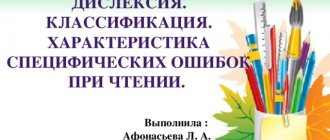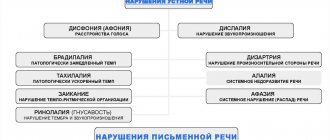The article presents the causes of specific reading and writing errors, provides a brief analysis of them, reveals the factors of the negative impact of reading and writing impairments on the mental development, behavior, successful learning and socialization of the child, and proposes a program of comprehensive pedagogical support for schoolchildren with written language impairments.
Reading and writing are one of the main tools for understanding the world. Due to their cultural significance, reading and writing are phenomena of civilization, they are products of human development and unique characteristics that distinguish humans from all other living beings. Mastering written language is associated with qualitative changes in the intellectual, emotional and volitional spheres of students’ personality.
Mastering reading and writing skills, that is, literacy, is a necessary condition not only for the adaptation of students in the process of schooling, but also affects the process of socialization of the child.
Reading and writing disorders
In recent years, there has been a tendency to increase the number of children suffering from reading and writing disorders. The significant prevalence of these disorders among younger schoolchildren complicates the educational process as a whole and prevents children from fully mastering school knowledge.
Schoolchildren experience numerous types of difficulties in mastering reading. These include: a large number of errors in the reading process, their frequency and persistence; violation of not only the technical, but also the semantic side of reading; slow pace of reading skill development.
The following are noted as frequent and persistent errors when reading:
- replacement of articulatory and acoustically similar sounds;
- replacing sounds corresponding to letters similar in style (t-g, sh-sch, x-z, p-n);
- omissions, rearrangements, additions of sounds and syllables,
- agrammatism when reading.
Mixtures of letters denoting sounds that are similar in acoustic-articulatory characteristics are caused by a violation of phonemic perception (due to difficulties in acoustic or kinesthetic analysis).
Omissions of letters , perseveration and anticipation of letters are caused by immaturity of the skill of sound analysis and synthesis, a violation of dynamic motor functions (serial organization of movements), as well as a violation of attention (voluntary regulation).
The reason for the rearrangement of letters is a violation of sound analysis and synthesis, immaturity of dynamic motor functions, the tracking stereotype and graphic activity from left to right in non-right-handed students.
Mixtures of graphically similar letters in writing (i-u, t-p, b-d, x-z, l-m) are caused by a violation of visual and visuospatial functions, dynamic motor functions (serial organization of movements), and a violation of kinesthetic analysis of the article.
Optical errors in reading and mirror errors are caused by impaired visual and visuospatial functions.
Errors in marking the boundaries of sentences and words are associated with undeveloped skills of language analysis and synthesis, and impaired attention (voluntary regulation).
The main reasons for the shortcomings in the development of writing skills are violations of oral speech, immaturity of phonemic processes (phonemic perception, phonemic analysis and synthesis) and low cognitive activity.
Introduction
A large number of studies and publications are devoted to the problem of writing disorders in children - dysgraphia, but the relevance of its study does not decrease. The interest of scientists is due to many factors, and in particular such as:
• high prevalence of writing impairments among first-grade students and their further development into persistent dysgraphia;
• the need to organize timely prevention, full diagnosis and effective correction of writing disorders;
• the variety of causes and complexity of the mechanisms of dysgraphia, attracting the attention of specialists from different fields of science (speech therapists, psychologists, neuropsychologists, clinicians).
Particular interest in the study of dysgraphia is also due to the fact that it is a specific disorder of speech activity in children and, at the same time, a violation of the acquisition and functioning of one of the most important school skills - writing. The presence of dysgraphia prevents children from mastering written language as a special form of speech, a unique means of communication and generalization of experience, the development of which is associated with qualitative changes in the intellectual, emotional, volitional and other spheres of the student’s personality (V. I. Lyaudis, I. P. Negure, 1994) .
Speech therapy methods for the prevention, diagnosis and correction of handwriting and written speech disorders in children have remained almost unchanged for many decades. However, to date, the study of dysgraphia in the course of professional training of speech therapists is, as a rule, limited to the traditional pedagogical approach, linking writing impairment either with the defective linguistic development of children or with optical-spatial disorders. Meanwhile, the practice of speech therapists working with the modern generation of junior schoolchildren suffering from dysgraphia indicates the need to make significant changes in the organization and content of speech therapy work. This is dictated, first of all, by changes in the development of children that have occurred in recent decades. Numerous studies by psychologists and neuropsychologists indicate that it is unlawful to assess the somatic and mental status of a child based on the norms of yesterday. The development of modern children has both tempo and qualitative features, and specialists need to take into account modifications of the ontogenetic process when organizing both diagnostic and correctional work (A.V. Semenovich, 2001).
Diagnostic criteria
The main diagnostic criteria for writing disorders include:
- presence of specific errors,
- their frequency and
- durability.
Errors associated with unformed phonemic and syllabic analysis include:
- omissions of vowels and consonants;
- adding, rearranging letters;
- omission, rearrangement and addition of syllables.
Errors associated with unformed analysis and synthesis of sentences : combined or separate spelling of words, omission of words and periods at the end of a sentence. Characteristic is the replacement of a capital letter with a lowercase one.
In case of writing disorders, substitutions of letters that are similar in acoustic and optical characteristics, omissions and insertions reflect the immaturity of phonemic and optical representations, weakness of auditory-speech and visual memory.
Substitutions of letters that are similar in articulatory characteristics, omissions of consonants and vowels are caused by insufficiency of the kinesthetic factor.
Omissions of consonants in combinations, insertions of vowels in combinations of consonants, repetition of syllables, letters, words, replacement of letters consisting of identical but presented in different numbers of elements (w - i, t - p), some calligraphic difficulties are explained by the immaturity of the kinetic factor.
The mixing of letters that have identical but differently located elements in space, cases of “mirror” writing are explained by a violation of the spatial factor.
A large number of spelling errors and affective influences indicate a lack of randomness.
Slow writing speed and rapid fatigue indicate a violation of the energy factor.
Most specific errors are multifactorial in nature, that is, they have several probable mechanisms of occurrence.
Types of dysgraphia
Classification of dysgraphia is carried out on the basis of the following criteria: taking into account impaired analyzers, mental functions, immaturity of writing operations.
The disorder rarely manifests itself in a single form, more often it is of a mixed nature and depends on the severity of the disorders in the preschool period, therefore, in written work you can see errors of both a grammatical and phonemic nature at the same time.
The above types of dysgraphia, as a rule, are permanent and stable. In some cases, they may be accompanied by non-speech deviations: weakened memory, absent-minded attention, mental illness.
Diagnostics
Dysgraphia can be diagnosed by a psychologist, including a school psychologist... He will conduct academic and written tests to determine the child’s ability to express thoughts in words, evaluate fine motor skills (for example, tapping a rhythm with your fingers or turning your wrist in a certain way...).
The specialist may ask you to write sentences or copy words and letters. At this time he will look at
- writing process;
- position of hands and body when writing;
- will evaluate the work of fine motor skills;
- will analyze the completed work.
If a child’s predisposition to dysgraphia is revealed, the first step is to exclude any other diseases or conditions that may cause difficulties with writing.
Main features
Parents or teachers may notice symptoms and identify a predisposition to dysgraphia when a child is just starting to study writing at school, but regular grammar lessons do not bring the desired result.
We wrote above about the manifestations of dysgraphia. But there are a number of other signs that will help identify the problem:
- the desire to avoid all types of activities related to written speech;
- difficulties in composing a story from pictures, memorizing poetry;
- Doing homework assignments takes a lot of time and causes a storm of negative emotions;
- dependence of handwriting on the emotional state (the more upset, the worse the handwriting);
- difficulty placing letters/words on paper or in the margins (poor spatial planning);
- frequent erasure/strikethrough;
- discrepancy in the distance between letters and words;
- mirror inversion of letters along the vertical/horizontal axis; changing the sequence of letters in a word;
- poor spelling, including unfinished words or missing words or letters;
- lack of punctuation marks and capital letters;
- unusual position of the wrist, body or paper when writing, gripping the pen tightly when writing (can lead to hand pain).
Dysgraphics may be confused in the order of seasons and days of the week; have poor understanding of left-right concepts and have difficulty fastening buttons and tying shoelaces. They find it difficult to write and think at the same time, and creative writing tasks are often overwhelming...
Causes
Writing problems usually occur in conjunction with other learning difficulties. Thus, many errors when writing can be caused by dyslexia (difficulty with reading). And poor handwriting is due to dyspraxia (a person’s ability to coordinate and perform motor tasks). Dysgraphia often occurs in children with ADHD (attention deficit hyperactivity disorder), delayed development of oral speech, left-handed people and ambidextrous people.
In addition, it is necessary to consider
Recommendations for parents: how to help your child?
Dysgraphia does not mean that a child is stupid or lazy. With the help and support of parents and specialists, the disease can be corrected, thereby reducing its negative impact on the learning process. Dysgraphia is not a death sentence!
Initially, speech therapy correction is indicated for children with dysgraphia. The sooner you seek help from specialists, the sooner you will ease your child’s “school suffering.” As parents, you can provide helpful preventative activities at home that promote writing and fine motor skills, such as
- playing with clay and plasticine to strengthen arm muscles;
- drawing and holding lines inside the maze to develop motor control;
- connecting dots or dashes to create complete letter forms;
- drawing letters with the index finger or an eraser (at the end of a pencil);
- writing letters in the air;
- mental representation of a letter;
- writing a letter from memory at a time interval that gradually increases in duration;
- copying letters;
- letter from dictation, etc.
In addition, to develop writing speed, it is useful to write any texts for 5 - 10 minutes daily. For home studies, you can find and download for free the book by O.V. Chistyakova “Correcting dysgraphia. 500 exercises for students in grades 1-4."
Dear Parents! “Dysgraphics” often understand their problem and are afraid of its manifestation. Therefore, they may skip lessons, lose writing notebooks, communicate little... The task of adults in this case is not only treatment, but also providing psychological support to children. It is important to prevent the child from becoming disgusted with activities, tiredness and dissatisfaction with himself!
I believe that of all the ways that can be used in a child’s fight against dysgraphia, one is especially important - to show that you are always there, especially when it is difficult and scary for him. That you love him for who he is, without any conditions! And there are no difficulties that you cannot overcome together... This way you will increase your child’s self-esteem and self-confidence, and help maintain motivation to work on difficult writing skills. And your relationship will become even warmer and more friendly...







